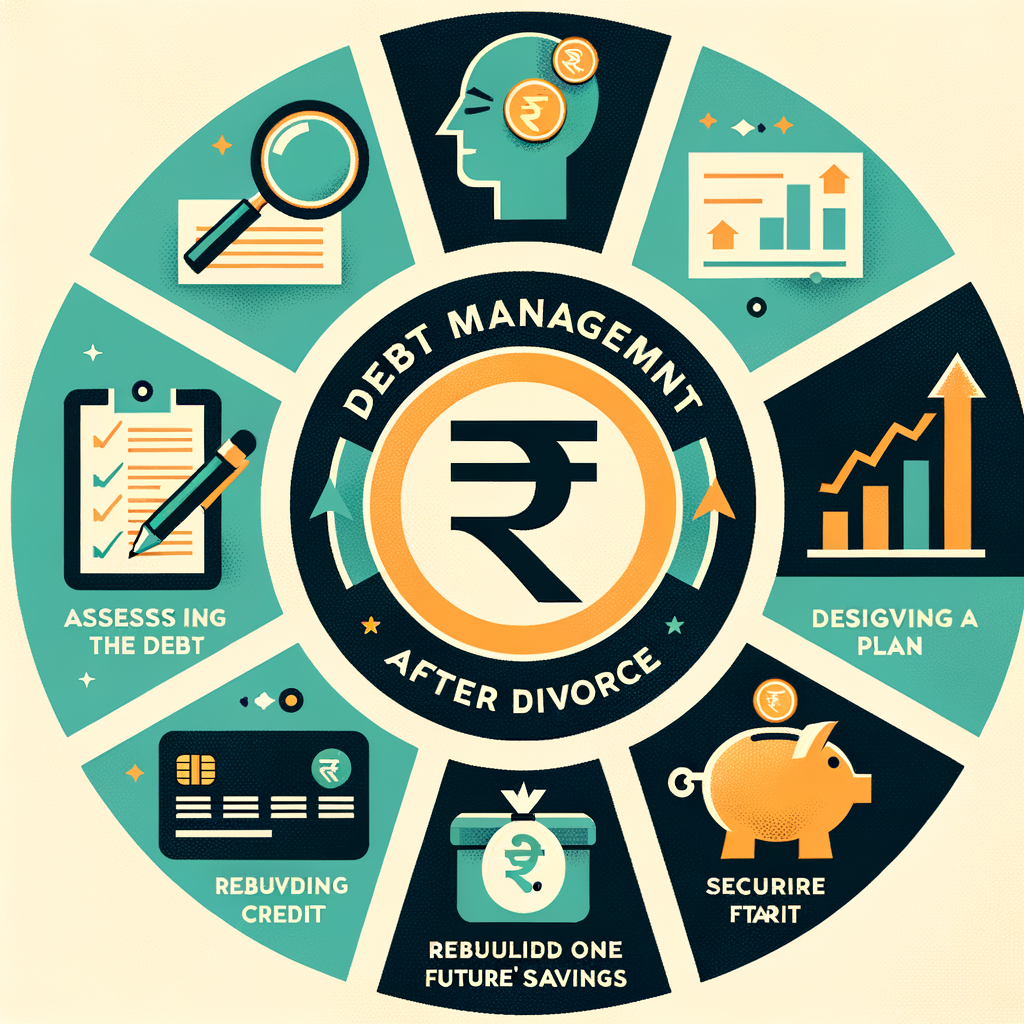How to Manage Debt After Divorce: Steps for a Fresh Financial Start
Divorce is an emotionally taxing journey, and the financial upheaval that often follows can add a significant layer of stress. As you navigate this new chapter, one of the most pressing challenges is figuring out how to untangle shared finances and liabilities. This guide is designed to help you manage debt after divorce, providing clear, actionable steps for a fresh financial start. For those in India, the process comes with its own set of nuances, making it crucial to have a solid plan for financial recovery after divorce in India. By taking control of your finances now, you can build a secure and independent future.
Understanding Your New Financial Reality
Before you can tackle your debt, you must have a crystal-clear picture of your current financial standing. This foundational step involves honestly assessing where you are right now, understanding your legal obligations, and taking immediate action to protect your financial identity. Skipping this phase is like trying to navigate a new city without a map; you might eventually find your way, but the process will be far more stressful and inefficient. A thorough assessment provides the clarity needed to make informed decisions and build an effective debt management strategy.
Take Stock: Create a Clear Financial Inventory
The first of the many steps to manage finances after divorce in India is to create a comprehensive list of everything you own and everything you owe. This financial inventory is your starting point. Begin by listing all your assets, which include your savings account balance, fixed deposits, mutual fund investments, property, and any other valuable possessions. Next, list all your liabilities, such as outstanding home loans, car loans, personal loans, and credit card balances.
It is crucial to differentiate between two types of debt:
- Individual Debts: These are loans or credit lines that are solely in your name. You are the only person responsible for repaying them.
- Joint Debts: These are liabilities you and your ex-spouse took on together, such as a joint home loan or a shared credit card. It is vital to understand that even if your divorce agreement states your ex-spouse is responsible for a joint debt, lenders are not bound by this agreement. From the bank’s perspective, both parties on the original loan agreement are 100% responsible for the entire amount until it is paid off.
Deciphering Your Divorce Decree
Your divorce decree is the legal document that officially outlines the division of assets and liabilities between you and your former spouse. You must read and understand this document thoroughly, preferably with the guidance of your lawyer, to know exactly which debts you are legally obligated to pay according to the court’s order. However, there is a critical distinction to be made here: the court’s decree is an agreement between you and your ex-spouse, not between you and your creditors. A bank or lending institution entered into a contract with both of you for a joint loan. If your ex-spouse is ordered to pay a joint loan but fails to do so, the creditor has the legal right to come after you for the entire amount. This reality underscores the importance of not just relying on the decree but actively working to separate your financial ties with lenders.
Immediate Steps to Protect Your Credit Score
Protecting your credit score during and after a divorce is paramount for your future financial health. A good credit score is essential for securing new loans, getting a credit card, or even renting a home. Delays or defaults on joint accounts, even if caused by your ex-spouse, will negatively impact your score. Here are some urgent actions you should take:
- Close All Joint Accounts: Contact your banks and credit card companies to close all joint accounts immediately. This prevents any new debt from being accumulated that you could be held responsible for.
- Remove Authorized Users: If your ex-spouse was an authorized user on any of your individual credit cards, have their name removed right away.
- Open New Individual Accounts: Open a new savings and chequing account in your name only. Reroute your salary and other income to this new account to maintain full control.
- Check Your CIBIL Report: Obtain a recent copy of your credit report to check for any inaccuracies or unfamiliar accounts. You can get your official report from the CIBIL website. Monitoring your report is a key part of
rebuilding credit after divorce India. For a detailed guide, see our post on How to Track Your Credit History Using Your PAN Card Via CIBIL.
A Step-by-Step Guide to Manage Debt After Divorce
With a clear understanding of your financial landscape, you can now move on to the active phase of tackling your liabilities. This structured approach will help you regain control, reduce stress, and methodically work your way toward becoming debt-free.
Step 1: Create a Realistic Post-Divorce Budget
Your financial life has changed significantly, and your old budget is no longer relevant. Creating a new, realistic budget is the cornerstone of effective financial management. This budget must be based on your new single-income reality and account for new expenses you may not have had before, such as rent, full utility payments, or child support. A good starting point for budgeting after divorce for Indian residents is a simple income-versus-expenses model.
- Income: List all your sources of income, including your monthly salary, any business income, alimony or maintenance payments received, and interest from investments.
- Fixed Expenses: These are costs that remain relatively constant each month. Include your rent or new EMI, insurance premiums, children’s school fees, and any fixed subscription services.
- Variable Expenses: These costs fluctuate monthly. Track your spending on groceries, transportation (fuel, public transport), electricity and water bills, and entertainment. Be realistic here.
- Debt Repayments: List the minimum monthly payments required for all your debts, including credit cards and loans. Your budget should clearly show how much money is left after all expenses and minimum debt payments are covered. This surplus is what you can use to accelerate your debt repayment.
Step 2: Prioritize Your Debts Strategically
Not all debts are created equal. To develop effective debt management strategies post-divorce India, you need to prioritize them based on their type and interest rate. This strategic approach ensures you are allocating your resources where they will have the most impact.
- Secured Debts: These are loans backed by an asset, like a home loan (backed by your house) or a car loan (backed by your vehicle). These should be your top priority. If you fail to make payments on secured debts, the lender can legally seize the asset. Keeping up with these payments is crucial to maintaining stability, especially if it involves your primary residence.
- Unsecured Debts: These include personal loans, credit card balances, and medical bills. They are not backed by any collateral. While there is no immediate risk of losing an asset, these debts often carry significantly higher interest rates. The high interest can cause the outstanding balance to grow quickly, making them expensive and difficult to pay off over time.
Step 3: Implement Proven Debt Reduction Strategies
Once your debts are prioritized, you can choose a repayment method that works for your financial situation and psychological mindset. Two of the most popular debt reduction tips for divorced individuals India are the Snowball and Avalanche methods.
| Strategy | How It Works | Best For |
|---|---|---|
| Debt Snowball Method | You focus on paying off the smallest debt first, regardless of the interest rate, while making minimum payments on all others. Once the smallest debt is cleared, you roll that payment amount onto the next-smallest debt. | Individuals who need quick, motivational wins to stay on track. The psychological boost of clearing a debt can provide powerful momentum. |
| Debt Avalanche Method | You focus on paying off the debt with the highest interest rate first, while making minimum payments on all others. Once that debt is cleared, you apply its payment to the debt with the next-highest interest rate. | Individuals who are disciplined and want to save the most money on interest over the long term. This method is the most financially efficient. |
For a deeper dive into these methods, read our guide on Debt Snowball vs. Debt Avalanche: Which Strategy Is Best for You?.
Step 4: Communicate Proactively with Lenders
It can be tempting to avoid calls from creditors, especially when you are feeling overwhelmed. However, ignoring the problem will only make it worse. Be proactive and communicate with your lenders. Call them, explain your situation calmly and honestly, and let them know you are committed to repaying your debt. Many lenders are willing to work with you if you are transparent. You can explore options such as refinancing a joint loan into an individual one (if your income qualifies), requesting a temporary reduction in your EMI, or negotiating a more manageable payment plan. Open communication can prevent your account from going into default and protect your credit score from further damage.
Financial Planning for Post-Divorce Life in India
Successfully managing debt is the first step. The next is to shift your focus toward building a secure and prosperous future. This is where financial planning for post-divorce life in India becomes essential, empowering you to move from a state of recovery to a state of growth.
Rebuilding Your Credit Score
A divorce, especially a contentious one involving joint debts, can take a toll on your CIBIL score. Rebuilding credit after divorce India is a gradual process that requires discipline and consistency. Here are some concrete steps to improve your score:
- Make All Payments on Time: Payment history is the single most important factor affecting your credit score. Set up automatic payments for all your bills and EMIs to ensure you never miss a due date.
- Keep Credit Utilization Low: On your individual credit cards, try to use less than 30% of your available credit limit. High utilization can signal financial stress to lenders.
- Consider a Secured Credit Card: If you have a damaged credit history or no credit history in your own name, a secured credit card can be an excellent tool. You provide a fixed deposit as collateral, and the bank issues a card with a limit based on that amount. Using it responsibly will help build a positive credit history.
Setting New Financial Goals
Now that you are in control of your finances, you can start dreaming and planning for the future. Setting clear, achievable financial goals will give you direction and motivation.
- Emergency Fund: Your first priority should be to build an emergency fund. Aim to save at least 3-6 months’ worth of essential living expenses in a separate, easily accessible savings account. This fund will protect you from unexpected financial shocks without forcing you into debt. You can learn more about this crucial step in our guide on Building an Emergency Fund While Managing Debt.
- Retirement Planning: Divorce can significantly impact retirement plans. Review your current retirement savings in accounts like the Public Provident Fund (PPF), National Pension System (NPS), and mutual funds. You may need to increase your contributions to get back on track with your long-term goals.
- Investment Strategy: Your risk tolerance and financial goals may have changed. Re-evaluate your investment portfolio to ensure it aligns with your new life stage. Consider consulting a financial advisor to help you create a strategy that balances growth and security.
Updating Essential Documents and Nominations
This is a critical administrative task that is often overlooked in the aftermath of a divorce. Failing to update your beneficiaries can lead to your assets unintentionally going to your ex-spouse.
- Update beneficiaries on your life and health insurance policies.
- Change the nominations on your bank accounts, PPF, Employee Provident Fund (EPF), and mutual fund investments.
- Create a new Will or update your existing one to reflect your current wishes.
Special Considerations for Small Business Owners
For entrepreneurs and small business owners, divorce can introduce another layer of financial complexity, especially when the business itself is intertwined with marital finances.
Separating Business and Personal Finances
If you haven’t already, now is the time to draw a firm line between your business and personal finances. This is non-negotiable. Maintain separate bank accounts, credit cards, and lines of credit for your business. This practice not only simplifies accounting and tax filing but also protects your personal assets from business liabilities and vice-versa. In the context of a divorce, it provides clarity on what constitutes a business asset versus a marital asset, potentially simplifying the division process.
Business Loan Liabilities After Divorce
The situation can become complicated if a business loan was taken out jointly with your ex-spouse or if they acted as a personal guarantor. Just like with personal joint debts, the lender will still consider both parties responsible for the loan, regardless of what your divorce decree says about the ownership of the business. If your ex-spouse is a co-applicant or guarantor, it’s crucial to approach the bank to discuss restructuring the loan. You may be able to refinance the loan solely in your name, provided your business’s financials and your personal credit are strong enough to support it.
Conclusion
Navigating the financial landscape after a divorce is undoubtedly challenging, but it is also an opportunity for a true fresh start. By taking deliberate steps to assess your situation, create a new budget, prioritize your debts strategically, and plan for your future, you can overcome this hurdle. It is entirely possible to manage debt after divorce and build a foundation of financial independence and security. The key is to be proactive, organized, and patient with yourself as you move forward.
Feeling overwhelmed? The financial experts at TaxRobo can help you create a personalized plan for financial recovery after divorce in India. Contact us for a consultation on financial planning, accounting, and legal advisory services.
Frequently Asked Questions (FAQs)
1. What happens to a joint home loan after divorce in India?
Answer: Legally, both parties remain equally responsible for the EMI in the eyes of the bank. The divorce decree may assign responsibility to one person, but if they default, the bank can pursue both individuals for the full amount. Common solutions include selling the property and splitting the proceeds after clearing the loan, one spouse buying out the other’s share by refinancing the loan in their sole name, or continuing to pay the EMI jointly until the loan is cleared.
2. Can my ex-spouse’s financial behaviour affect my CIBIL score after our divorce?
Answer: Yes, it absolutely can if you still have any active joint accounts. Any late payment, missed payment, or default on a joint loan or credit card will be reported on both of your credit files, negatively impacting both of your CIBIL scores. This is why closing all joint financial products is one of the most critical steps to manage debt after divorce and protect your individual creditworthiness.
3. How can I start rebuilding my credit after a divorce in India?
Answer: A great way to start is by getting a credit card in your own name. If you’re finding it difficult to get approved for a traditional unsecured card, apply for a secured credit card, which is issued against a fixed deposit. Use this card for small, regular purchases and make sure to pay the entire balance in full and on time every single month. This consistent, positive payment behaviour is the fastest way to begin rebuilding credit after divorce India and establishing your own strong credit history.



